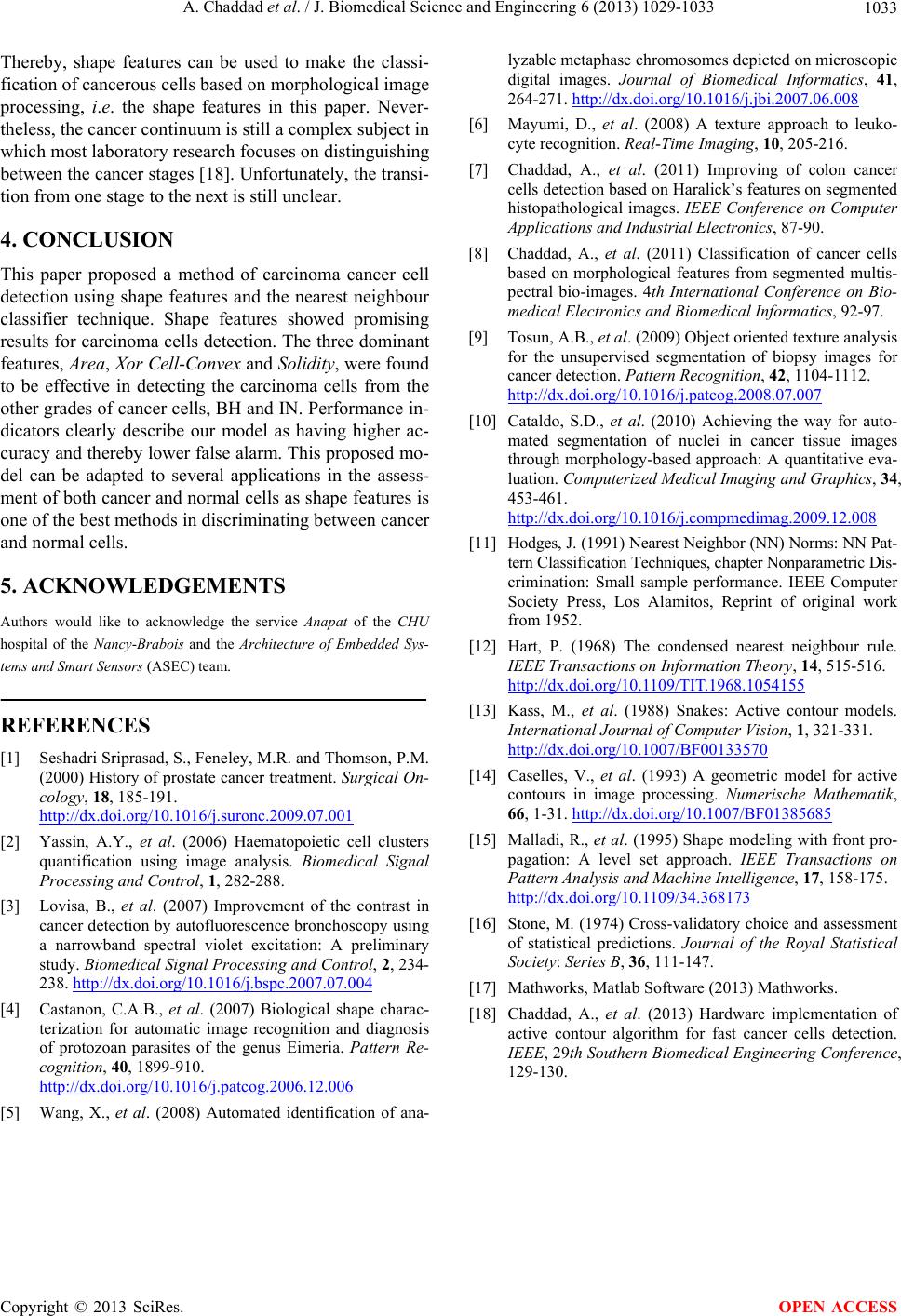
A. Chaddad et al. / J. Biomedical Science and Engineering 6 (2013) 1029-1033 1033
Thereby, shape features can be used to make the classi-
fication of cancerous cells b ased on morphological image
processing, i.e. the shape features in this paper. Never-
theless, the cancer continuum is still a complex subject in
which most laboratory research focuses on distinguishing
between the cancer stages [18]. Unfortunately, the transi-
tion from one stage to the next is still unclear.
4. CONCLUSION
This paper proposed a method of carcinoma cancer cell
detection using shape features and the nearest neighbour
classifier technique. Shape features showed promising
results for carcinoma cells detection. The three dominant
features, Area, Xor Cell-Convex and Solidity, were found
to be effective in detecting the carcinoma cells from the
other grades of cancer cells, BH and IN. Performance in-
dicators clearly describe our model as having higher ac-
curacy and thereby lower false alarm. This proposed mo-
del can be adapted to several applications in the assess-
ment of both cancer and normal cells as shape features is
one of the best methods in discriminating between cancer
and normal cells.
5. ACKNOWLEDGEMENTS
Authors would like to acknowledge the service Anapat of the CHU
hospital of the Nancy-Brabois and the Architecture of Embedded Sys-
tems and Smart Sensors (ASEC) team.
REFERENCES
[1] Seshadri Sriprasad, S., Fe neley, M.R. and Thomson, P.M.
(2000) History of prostate cancer treatment. Surgical On-
cology, 18, 185-191.
http://dx.doi.org/10.1016/j.suronc.2009.07.001
[2] Yassin, A.Y., et al. (2006) Haematopoietic cell clusters
quantification using image analysis. Biomedical Signal
Processing and Control, 1, 282-288.
[3] Lovisa, B., et al. (2007) Improvement of the contrast in
cancer detection by autofluorescence bronchoscopy using
a narrowband spectral violet excitation: A preliminary
study. Biomedical Signal Processing and Control, 2, 234-
238. http://dx.doi.org/10.1016/j.bspc.2007.07.004
[4] Castanon, C.A.B., et al. (2007) Biological shape charac-
terization for automatic image recognition and diagnosis
of protozoan parasites of the genus Eimeria. Pattern Re-
cognition, 40, 1899-910.
http://dx.doi.org/10.1016/j.patcog.2006.12.006
[5] Wang, X., et al. (2008) Automated identification of ana-
lyzable me taphase c hromosome s depicted on microscopic
digital images. Journal of Biomedical Informatics, 41,
264-271. http://dx.doi.org/10.1016/j.jbi.2007.06.008
[6] Mayumi, D., et al. (2008) A texture approach to leuko-
cyte recognition. Real-Time Imaging, 10, 205-216.
[7] Chaddad, A., et al. (2011) Improving of colon cancer
cells detection based on Haralick’s features on segmented
histopathological images. IEEE Conference on Computer
Applications and Industrial Electronics, 87-90.
[8] Chaddad, A., et al. (2011) Classification of cancer cells
based on morphological features from segmented multis-
pectral bio-images. 4th International Conference on Bio-
medical Electronics and Biomedical Informatics, 92-97.
[9] Tosun, A.B., et al. (2009) Object oriented texture analysis
for the unsupervised segmentation of biopsy images for
cancer detection. Pattern Recognition, 42, 1104-1112.
http://dx.doi.org/10.1016/j.patcog.2008.07.007
[10] Cataldo, S.D., et al. (2010) Achieving the way for auto-
mated segmentation of nuclei in cancer tissue images
through morphology-based approach: A quantitative eva-
luation. Computerized Medical Imaging and Graphics, 34,
453-461.
http://dx.doi.org/10.1016/j.compmedimag.2009.12.008
[11] Hodges, J. (1991) Nearest Neighbor (NN) Nor ms: NN Pat -
tern Classification Techniques, chapter Nonparametric Dis-
crimination: Small sample performance. IEEE Computer
Society Press, Los Alamitos, Reprint of original work
from 1952.
[12] Hart, P. (1968) The condensed nearest neighbour rule.
IEEE Transactions on Information Theory, 14, 515-516.
http://dx.doi.org/10.1109/TIT.1968.1054155
[13] Kass, M., et al. (1988) Snakes: Active contour models.
International Journal of Computer Vision, 1, 321-331.
http://dx.doi.org/10.1007/BF00133570
[14] Caselles, V., et al. (1993) A geometric model for active
contours in image processing. Numerische Mathematik,
66, 1-31. http://dx.doi.org/10.1007/BF01385685
[15] Malladi, R., et al. (1995) Shape modeling with front pro-
pagation: A level set approach. IEEE Transactions on
Pattern Analysis and Machine Intelligence, 17, 158-175.
http://dx.doi.org/10.1109/34.368173
[16] Stone, M. (1974) Cross-validatory choice and assessment
of statistical predictions. Journal of the Royal Statistical
Society: Series B, 36, 111-147.
[17] Mathworks, Matlab Software (2013) Ma thworks.
[18] Chaddad, A., et al. (2013) Hardware implementation of
active contour algorithm for fast cancer cells detection.
IEEE, 29th Southern Biomedical Engineering Conference,
129-130.
Copyright © 2013 SciRes. OPEN ACCESS